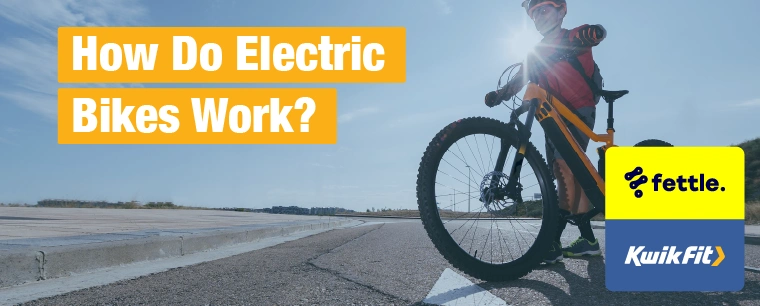How Do Electric Bikes Work?
Jack Dreyer | Friday 15th December 2023 8:00am

Electric bikes have been taking the transport world by storm in the last few years – not only are they entirely eco-friendly (if powered from renewably sourced electricity) but they’re an affordable, practical alternative to city-zipping cars.
At the moment, of course, they’re not as affordable as a fully manual bicycle, but they’re perfect for those who’ve let their fitness slide or those with some mobility issues – letting riders get further, faster without exhausting themselves entirely.
But how do they actually work? Let’s find out!
They work primarily by pedal power
Legally-speaking, electric bikes still have to be primarily powered by pedalling in order to avoid being classed as motor vehicles. This means that, usually, you’re using a good amount of manual energy to get the bike going. It’s not the same as switching to an electric car that, like any car, gives you all of the horsepower itself.
The core attraction of e-bikes is that your pedalling can be assisted by the bike relative to the setting you have set for the motor. While many e-bikes have a ‘throttle’ option like those you’d find on a motorbike, relying solely on the throttle without cycling significantly reduces your motor range (because you have to use a lot more power) and also limits your maximum possible speed.
In fact, EU law actually enforces that e-bike motors cut off any assistance after 15.5 mph. So you have to pedal manually to go faster than that.
What’s great about this is that you don’t end up in dangerous situations by just setting your bike to whatever maximum power setting is available. You still have to be in charge of pedalling actively. Moreover, most of the hard work of pedalling is when going at slow speeds, so this 15 mph cut-off is actually perfect for most uses.
How do e-bikes work?
So, fundamentally, e-bikes work with a battery-powered electric motor (which works in exactly the same way as the electric motors in EVs) that gives extra help to your pedalling motion.
Where that motor is placed on the bike differs, at the moment, with two fundamental designs: Mid Motor designs and Hub Motor designs – each with their respective pros and cons.
What are e-bike mid motors?
A mid motor design replaces a conventional bike’s bottom bracket and the hub assembly with a motor.
Because bike gears work in a forward-ratchet motion (that is, they can roll over themselves until you pedal more), you can coast as easily as you could on a normal bicycle – the electric motor literally just adds a bit of extra oomph when you need it.
This is actually not too different in principle than how power steering works: you still have to steer in order to direct the wheels, but a motor helps to amplify the force you provide so that you can drive a larger vehicle more accurately than was possible in the days of manual steering.
What are e-bike hub motors?
Hub motors replace the rear gear hub assembly – the bit the chain connects to on your rear bike wheel. So, rather than assisting your pedalling directly, a hub motor helps the rear wheel (which is the “driving” wheel) turn faster – which indirectly helps you pedal as you won’t need to pedal with as much force.
The fundamental principle is the same in both – namely, that both designs help you cycle without as much effort – but their differences are largely in dependability & cost.

Mid & hub motor pros & cons
Mid motors tend to be more responsive to your pedal input because they are your pedal input – but bikes with mid motors tend to be considerably more expensive than hub-motor bikes because the mid motors need to be custom designed and manufactured for the frame of the bike.
As a further consequence, they also then tend to be more expensive to repair because they’ll usually use proprietary parts.
Hub motors, on the other hand, can be priced a lot lower than mid motors because a core wheel design can be reused for different bike designs – with the only difference being spoke length & motor power.
They’ll therefore also tend to be much easier to repair or replace – but this comes at the cost of, generally, needing to repair or replace hub motors more regularly than mid motors. Because they take a lot of the driving force from your pedalling, hub motors tend to wear out faster.
Keep your e-bike singing at Kwik Fit
Whichever bike design you’ve opted for, be sure to invest in regular maintenance & servicing to keep it shipshape for as long as possible. We’ve teamed up with e-bike servicing & repair specialists, Fettle, to offer e-bike services right in our centres – find your nearest Fettle station here.
Any facts, figures and prices shown in our blog articles are correct at time of publication.
Featured Articles
Is it Illegal to Drive With One Headlight?
Saturday 19th July 2025
Wondering if it’s illegal to drive with one headlight? Learn about the safety risks and penalties of illegal blown bulbs and why you should fix them promptly.
Air Con in EVs & Hybrids: Experts Answer Your Questions
Monday 30th June 2025
Does air con drain EV batteries? Can you use the air con while charging an electric car? Find out the answers to these questions & more from Kwik Fit’s experts.
Why Is Your Car Making a Noise? Fixes & Tips
Friday 13th June 2025
When your car starts making unexpected noises, it can certainly be quite disconcerting; it may be nothing to worry about, but here’s what you need to know.









